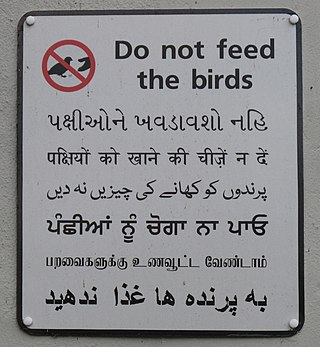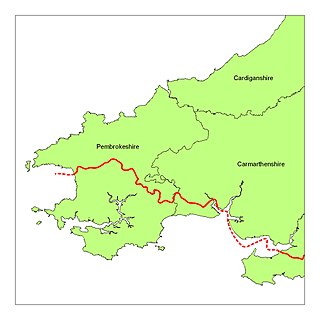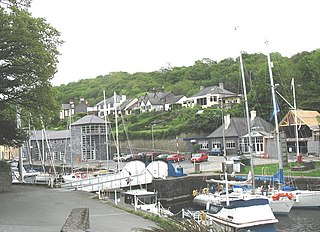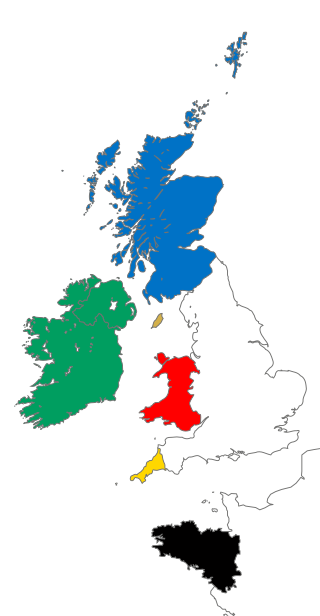Graphical summary 1750-1900
- Languages of Wales 1750–1900
- 1750
- 1800
- 1850
- 1900
Welsh, a Brythonic Celtic language, was historically spoken by the majority of Wales' population, with current estimates suggesting a third of the current population of Wales speak the language.

| Year | Number of speakers | % of population | % change since previous census |
|---|---|---|---|
| 1891 (first recording) | 910,289 [3] | **51.2 [3] | N/A |
| 1901 | 930,000 [4] | 50 [4] | −1.2 |
| 1911 | *977,366 [5] | 43.5 [5] | −6.5 |
| 1921 | 929,183 [6] | 37.4 [6] | −5.9 |
| 1931 | 909,261 [7] | 36.8 [7] | −0.6 |
| 1941 (no census held) | N/A | N/A | N/A |
| 1951 | 714,686 [7] | 28.9 [7] | −7.9 (in 20 yrs) |
| 1961 | 659,022 [7] | 26.0 [7] | −2.9 |
| 1971 | 542,425 [8] | 20.7 [8] | −5.3 |
| 1981 | 503,532 [9] | 19.0 [9] | −1.7 |
| 1991 | 508,000 [10] | 18.7 [10] | −0.3 |
| 2001 | 582,400 [11] | 20.5 [12] | +1.8 |
| 2011 | 562,000 [10] | 19.0 [10] | -1.5 |
| 2021 | 538,000 [13] | 17.8 [13] | -1.2 |
*largest population of Welsh speakers ever recorded in a census
**largest proportion of Welsh speakers ever recorded in a census
N/A: not applicable
Census figures denote those able to speak Welsh above the age of 3 years old. [14] [15]
| Year ending December unless otherwise stated | Number of speakers | % of population | % change since previous year |
|---|---|---|---|
| 2001 | 836,070 | 30.0 | N/A |
| 2002 | 811,043 | 29.0 | −1.0 |
| 2003 | 786,072 | 28.0 | −1.0 |
| 2004 | 767,960 | 27.1 | −0.9 |
| 2005 | 753,236 | 26.5 | −0.6 |
| 2006 | 757,423 | 26.5 | 0.0 |
| 2007 | 725,407 | 25.2 | −1.3 |
| 2008 | 763,858 | 26.4 | +1.2 |
| 2009 | 739,679 | 25.5 | −0.9 |
| 2010 | 742,331 | 25.5 | 0.0 |
| 2011 | 769,038 | 26.3 | +0.8 |
| 2012 | 768,734 | 26.2 | −0.1 |
| 2013 | 794,799 | 27.0 | +0.8 |
| 2014 | 812,515 | 27.5 | +0.5 |
| 2015 | 809,008 | 27.3 | −0.2 |
| 2016 | 842,717 | 28.3 | +1.0 |
| 2017 | 873,634 | 29.2 | +0.9 |
| 2018 | 898,375 | 29.9 | +0.7 |
| 2019 | 858,901 | 28.4 | −1.5 |
| 2020 | 883,069 | 29.1 | +0.7 |
| 2021 | 892,200 | 29.5 | +0.4 |
| 2022 (year ending in June) | 899,500 | 29.7 | +0.2 |
N/A: not applicable
Annual population survey figures indicate the number of people over the age of three years able to speak Welsh. [17] The number of speakers has been estimated based on the percentage of the population that speak Welsh and the general population size provided by the APS.
| School year | Welsh-Medium pupils [18] | Number of pupils in classes where Welsh | % of pupils in classes where Welsh |
|---|---|---|---|
| 1985 | 29,368 | 11.7 | |
| 1986 | 30,109 | 11.9 | |
| 1887 | 31,320 | 12.2 | |
| 1988 | 33,174 | 12.5 | |
| 1989/1990 | 45,387 | 36,441 | 13.5 |
| 1990/1991 | 46,773 | 38,404 | 14.1 |
| 1991/1992 | 43,984 | 43,984 | 16.0 |
| 1992/19943 | 46,088 | 46,088 | 16.6 |
| 1993/1994 | 48,845 | 46,950 | 16.4 |
| 1994/1995 | 47,907 | 49,382 | 17.1 |
| 1995/1996 | 49,187 | 50,327 | 17.2 |
| 1996/1997 | 49,472 | 50,392 | 17.2 |
| 1997/1998 | 50,398 | 51,853 | 17.7 |
| 1998/1999 | 50,118 | 51,600 | 17.7 |
| 1999/2000 | 49,545 | 51,336 | 17.8 |
| 2000/2001 | 49,422 | 51,087 | 17.9 |
| 2001/2002 | 49,687 | 51,344 | 18.2 |
| 2002/2003 | 50,756 | 51,977 | 18.7 |
| 2003/2004 | 51,131 | 52,064 | 19.1 |
| 2004/2005 | 52,792 | 52,857 | 19.6 |
| 2021/2022 | 90,715 |
*More than half of curriculum teaching is through the medium of Welsh
| School year | Welsh-Medium pupils [18] |
|---|---|
| 1988/1989 | 26,151 |
| 1989/1990 | 26,058 |
| 1990/1991 | 27,897 |
| 1991/1992 | 29,990 |
| 1992/1993 | 29,791 |
| 1993/1994 | 31,132 |
| 1994/1995 | 33,204 |
| 1995/1996 | 32,973 |
| 1996/1997 | 33,371 |
| 1997/1998 | 34,566 |
| 1998/1999 | 36,289 |
| 1999/2000 | 37,288 |
| 2000/2001 | 38,007 |
| 2001/2002 | 38,817 |
| 2002/2003 | 39,458 |
| 2003/2004 | 40,169 |

The Celtic languages are a group of related languages descended from Proto-Celtic. They form a branch of the Indo-European language family. The term "Celtic" was first used to describe this language group by Edward Lhuyd in 1707, following Paul-Yves Pezron, who made the explicit link between the Celts described by classical writers and the Welsh and Breton languages.

Welsh is a Celtic language of the Brittonic subgroup that is native to the Welsh people. Welsh is spoken natively in Wales, by some in England, and in Y Wladfa. Historically, it has also been known in English as "British", "Cambrian", "Cambric" and "Cymric".

The history of what is now Wales begins with evidence of a Neanderthal presence from at least 230,000 years ago, while Homo sapiens arrived by about 31,000 BC. However, continuous habitation by modern humans dates from the period after the end of the last ice age around 9000 BC, and Wales has many remains from the Mesolithic, Neolithic, and Bronze Age. During the Iron Age the region, like all of Britain south of the Firth of Forth, was dominated by the Celtic Britons and the Brittonic language. The Romans, who began their conquest of Britain in AD 43, first campaigned in what is now northeast Wales in 48 against the Deceangli, and gained total control of the region with their defeat of the Ordovices in 79. The Romans departed from Britain in the 5th century, opening the door for the Anglo-Saxon invasion. Thereafter, the Brittonic language and culture began to splinter, and several distinct groups formed. The Welsh people were the largest of these groups, and are generally discussed independently of the other surviving Brittonic-speaking peoples after the 11th century.

Wales is a country that is part of the United Kingdom. It is bordered by England to the east, the Irish Sea to the north and west, the Celtic Sea to the south west and the Bristol Channel to the south. It had a population in 2021 of 3,107,500 and has a total area of 20,779 km2 (8,023 sq mi). Wales has over 1,680 miles (2,700 km) of coastline and is largely mountainous with its higher peaks in the north and central areas, including Snowdon, its highest summit. The country lies within the north temperate zone and has a changeable, maritime climate. The capital and largest city is Cardiff.

Demographics of Wales include the numbers in population, place of birth, age, ethnicity, religion, and number of marriages in Wales.

English, in various dialects, is the most widely spoken language of the United Kingdom, but a number of regional and migrant languages are also spoken. Regional indigenous languages are Scots and Ulster Scots and the Celtic languages, Irish, Scottish Gaelic, Welsh and, as a revived language with few speakers, Cornish. British Sign Language is also used. There are also many languages spoken by immigrants who arrived recently to the United Kingdom, mainly within inner city areas; these languages are mainly from continental Europe and South Asia.

The Celtic Revival is a variety of movements and trends in the 19th, 20th and 21st centuries that see a renewed interest in aspects of Celtic culture. Artists and writers drew on the traditions of Gaelic literature, Welsh-language literature, and so-called 'Celtic art'—what historians call Insular art. Although the revival was complex and multifaceted, occurring across many fields and in various countries in Northwest Europe, its best known incarnation is probably the Irish Literary Revival. Irish writers including William Butler Yeats, Lady Gregory, "AE" Russell, Edward Martyn, Alice Milligan and Edward Plunkett stimulated a new appreciation of traditional Irish literature and Irish poetry in the late 19th and early 20th century.

Little England beyond Wales is a name that has been applied to an area of southern Pembrokeshire and southwestern Carmarthenshire in Wales, which has been English in language and culture for many centuries despite its remoteness from England. Its origins may lie in the Irish, Norse, Norman, Flemish and Saxon settlement that took place in this area more than in other areas of South West Wales. Its northern boundary is known as the Landsker Line.

Y Felinheli, formerly known in English as Port Dinorwic, is a village and community beside the Menai Strait between Bangor and Caernarfon in Gwynedd, northwest Wales.

The Welsh are an ethnic group native to Wales. "Welsh people" applies to those who were born in Wales and to those who have Welsh ancestry, perceiving themselves or being perceived as sharing a cultural heritage and shared ancestral origins.

The Celtic nations are a cultural area and collection of geographical regions in Northwestern Europe where the Celtic languages and cultural traits have survived. The term nation is used in its original sense to mean a people who share a common identity and culture and are identified with a traditional territory.
Welsh Americans are an American ethnic group whose ancestry originates wholly or partly in Wales. In the 2008 U.S. Census community survey, an estimated 1.98 million Americans had Welsh ancestry, 0.6% of the total U.S. population. This compares with a population of 3 million in Wales. However, 3.8% of Americans appear to bear a Welsh surname.

Religion in Wales has, over the years, become increasingly diverse. Christianity was the religion of virtually all of the Welsh population until the late 20th century, but it has rapidly declined throughout the early 21st century. Today a plurality (46.5%) of people in Wales follow no religion at all.

Education delivered through the medium of the Welsh language is known as Welsh-medium education .
The history of the Welsh language spans over 1400 years, encompassing the stages of the language known as Primitive Welsh, Old Welsh, Middle Welsh, and Modern Welsh.

The languages of Wales include the Welsh language, which is an official language of Wales, and English, which is also considered an official language in Wales. The official languages of the Senedd are also Welsh and English. According to the 2021 census, the Welsh-speaking population of Wales aged three or older was 17.8% and nearly three quarters of the population in Wales said they had no Welsh language skills.

The modern history of Wales starts in 1800 and continues until the present day. In the 19th century, South Wales became heavily industrialised with ironworks; this, along with the spread of coal mining to the Cynon and Rhondda valleys from the 1840s, led to an increase in population. The social effects of industrialisation resulted in armed uprisings against the mainly English owners. Socialism developed in South Wales in the latter part of the century, accompanied by the increasing politicisation of religious Nonconformism. The first Labour Party MP, Keir Hardie, was elected as a junior member for the Welsh constituency of Merthyr Tydfil and Aberdare in 1900.

Welsh national identity is a term referring to the sense of national identity, as embodied in the shared and characteristic culture, languages and traditions, of the Welsh people.
{{cite journal}}: Cite journal requires |journal= (help){{cite journal}}: Cite journal requires |journal= (help){{cite journal}}: Cite journal requires |journal= (help)